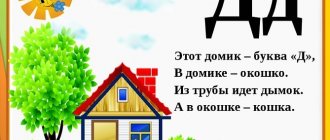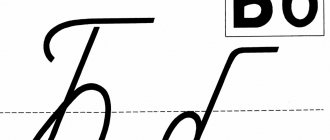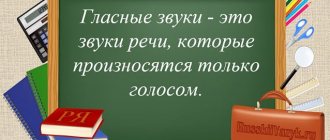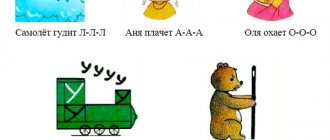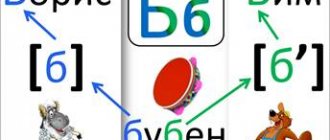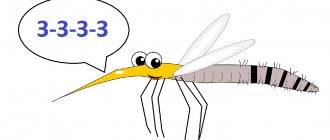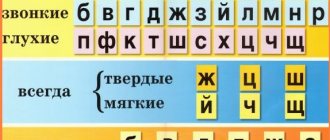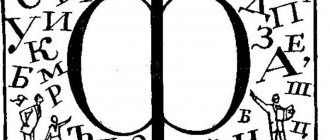- home
- Directories
- Handbook of Russian for elementary school
- Sounds and letters
- Consonant sounds and letters representing them
- Voiceless and voiced consonants
Consonant sounds can be pronounced with a greater or lesser degree of sonority. In accordance with this, voiced and voiceless consonants are distinguished.
Voiceless consonant sounds are made up of noise, while voiced consonant sounds are made up of noise and voice.
Some consonant sounds are paired in terms of voicedness and voicelessness , i.e. can be voiced or devoiced depending on their position in the word. And some are unpaired , i.e. their sound does not depend on position.
Table of consonant sounds paired and unpaired by voicedness/voicelessness:
| Groups consonants | Doubles | Unpaired |
| Voiced | [b], [b'], [c], [c'], [d], [g'], [d], [d'], [g], [h], [z'] | [th'], [p], [p'], [l], [l'], [m], [m'], [n], [n'] |
| Deaf | [p], [p'], [f], [f'], [k], [k'], [t], [t'], [w], [s], [s'] | [ts], [x], [x'], [h'], [w'] |
Consonant paired voiced sounds are deafened:
- at the end of the word - tooth b [zu p ], hundred g [hundred k ], plo v [plo f ]
- before voiceless consonant sounds - lips ki [gu p ki], spoon [ loshka ] , low [n'is ka ]
Consonant paired unvoiced sounds are voiced:
- before voiced consonant sounds - with delka [ z' d'elka], grind ba [small d' ba]
The correct spelling of paired consonants based on voicedness/voicelessness is an orthogram that requires a test word.
unpaired in terms of voicedness/voicelessness are not deafened or voiced, regardless of where in the word or before what sounds (voiced or voiceless) they are located.
For example: rubbish [litter], house [house], crust [crust], Dimka [dimka]
Share with friends on social networks:
Pairs of voiced and voiceless consonants
Voiced and unvoiced sounds and the letters denoting them are contrasted in Russian and form pairs:
- b-p,
- w-f,
- g-k,
- d-t,
- ss,
- w-sh.
If we take into account that the consonants in these pairs can also be soft (except zh-sh), then there are a total of 11 contrasting pairs of deafness and voicedness. The listed sounds are called paired. The remaining voiced and unvoiced sounds do not have pairs. The voiced unpaired ones include the above sonorants, and the voiceless ones include x, c, ch, shch. The table of consonants presented on our website will help you study these sounds in more detail.
Click on the picture to print a table with voiced and voiceless consonants
How is it that letters in the Russian alphabet can represent several sounds?
Features of the pronunciation of a sound are often predetermined by its position in the word. Thus, a voiced sound at the end of a word is deafened, and this position of the sound is called “weak”. Stunning can also occur before the next voiceless consonant, for example: pond, booth. We write voiced consonants and pronounce: twig, butka.
Conversely, a voiceless consonant can become voiced if it is followed by a voiced sound: threshing, but we pronounce maladba. Knowing this feature of Russian phonetics, we check the spelling of consonants at the end and middle of a word using test words: molotba - thresh, pond-ponds, booth - booth. We select the test word so that after the dubious consonant there is a vowel.
To remember what a sound is according to its characteristics, it is necessary to make mental associations of the sound with some object, event or natural sound. For example, the sound sh is similar to the rustling of leaves, and the sound z is similar to the hum of bees. The association will help you find your way in time. Another way is to create a phrase with a specific set of sounds.
Thus, knowing the letter-sound relationship is extremely important for spelling and correct pronunciation. Without studying phonetics, it is impossible to study and correctly perceive the melody of a language.
Video lesson about voiced and voiceless consonants:
Tralik and Valik about voiced and voiceless consonants
Another video lesson for children with riddles about voiced and voiceless consonants
Voiced
When they are formed, the shape of the tongue is close to the form that produces voiceless sounds, but vibrations are added. Voiced consonant sounds create active vibrations of the ligaments. Vibrations deform the sound wave , and it is not the pure flow of air that enters the oral cavity, but the sound. Subsequently, it is further transformed by the tongue and lips.
Voiced consonants include: b, c, g, d, g, z, j, l, m, n, r.
When they are pronounced, tension is clearly felt in the larynx area. In addition, it is almost impossible to speak them clearly in a whisper.
A word in which all consonants are voiced: Rome, pride, ash, estuary.
Summary table of consonants (voiceless and voiced).
| Sound | [b'] | [b] | [V'] | [V] | [G'] | [G] | [d'] | [d] | [and] | [z'] | [h] | [th] | [l] | [m] | [n] | [R] |
| Ch. | [P'] | [P] | [f'] | [f] | [To'] | [To] | [T'] | [T] | [w] | [With'] | [With] | [X] | [ts] | [h] | [sch] |
It is due to the change in sound that Russian speech is enriched with various words that are similar in spelling and pronunciation, but completely different in meaning . For example: house - volume, court - itch, code - year.
Voiceless and voiced consonants
Deaf
Quiet, it’s quite difficult to shout them. The vocal cords do not obstruct the movement of air from the lungs, and sound is formed by changing the shape of the lips and the position of the tongue.
Voiceless in Russian: [k], [p], [s], [t], [f], [x], [ts], [sh]. The easiest way to remember is a phrase, and not a set of letters, “Styopka, do you want a cheek? Fi!” containing them all.
An example in which all consonant sounds are unvoiced: rooster, honeycomb, pin.
This is interesting! How phonetic analysis of a word is done: an example of sound analysis
Hard and soft
They are the same in spelling, but different in sound. Voiceless and voiced consonants, with the exception of hissing ones, can be pronounced hard or soft. For example: [b] was – [b`] beat; [t] current – [t`] flowed.
When pronouncing hard words, the tip of the tongue is pressed against the palate. Soft ones are formed by pressing the middle part of the tongue against the upper palate .
In speech, the sound is determined by the letter following the consonant.
Vowels form pairs: a-ya, u-yu, e-e, y-i, o-yo.
Double vowels (I, ё, yu, e) are pronounced in one of two combinations: the sound [th] and a paired vowel from E, O, U, A, or a soft sign and a paired vowel. For example, the word cabin boy. It is pronounced [y] [y] [n] [g] [a]. Or the word mint. It is pronounced as: [m'] [a] [t] [a]. The vowels A, O, U, E, Y do not have a double sound, and therefore do not affect the pronunciation of the consonant in front .
Example difference:
A spoon is a hatch, honey is a sea, a house is a woodpecker.
Phonetic transcription:
[Spoon] – [L'uk], [m'o d] – [m o r'e], [house] – [d' a t e l].
Pronunciation rules:
- solid ones are pronounced before A, O, U, E, Y. Abscess, side, beech, Bentley, former;
- soft ones are pronounced before Ya, Yo, Yu, E, I. Revenge, honey, whale, mashed potatoes, mint;
- hard ones are pronounced if they are followed by another consonant: death. After the consonant [s] there is a consonant [m]. Regardless of whether the M is soft, voiced or hard, the S is pronounced firmly;
- solid ones are pronounced if the letter is the last in the word : class, house;
- Consonants before the vowel [e] in borrowed words are pronounced firmly, as before [e]. For example: muffler – [k] [a] [w] [n] [e];
- always soft before b: elk, pulp.
- exceptions to the rules: always solid F, W, C: life, thorns, cyanide;
- always soft Y, H, Sh: white, black, pike.
Hard and soft sounds
Paired consonants
What does consonant pairing mean? Two letters that are similar in sound and, when pronounced, take similar positions with the tongue, are called paired consonants. The pronunciation of consonants can be divided into one-stage (lips and tongues are involved in their creation) and two-stage - the ligaments are connected first, then the mouth. Those cases when, during pronunciation, mouth movements coincide and create pairs.
Summary table of paired consonants taking into account hardness and softness
| Sound | [b] | [b'] | [V] | [V'] | [G] | [G'] | [d] | [d'] | [h] | [z'] | [and] |
| Ch. | [P] | [P'] | [f] | [f'] | [To] | [To'] | [T] | [T'] | [With] | [With'] | [w] |
In speech, it is common not to pronounce each letter, but to “eat” it. This is not an exception only for Russian speech. This is found in almost all languages of the world and is especially noticeable in English. In Russian, this effect is subject to the rule: paired consonant sounds replace (auditory) each other during speech. For example: love – [l' u b o f'].
But not everyone has their own pair. There are some that are not similar in pronunciation to any others - these are unpaired consonants . The reproduction technique differs from the pronunciation of other sounds and combines them into groups.
Paired consonants
Whistling consonants
These include [z], [z'], [s], [s'], [ts], which are anterior lingual, breathing passes through the gap. When S and Z are pronounced firmly, the teeth are exposed, the tongue is at the bottom, but its sides are raised to the upper teeth, in the middle there is a longitudinal depression through which the breath passes, creating a noise similar to a whistle. When pronouncing softly, the back of the tongue touches the palate, the vocal cords tremble.
You can teach it to a child in this way: in front of a mirror, the baby should smile without opening his teeth, and blow the letter C strongly or whistle it. If this does not work, then it is recommended to consult a speech therapist.
These intonations must be taken seriously, because they are the ones that often cause problems in pronunciation, but in most cases they can be corrected. Children should pronounce whistling tones correctly at 3-3.5 years of age.
The sounds [z] and [s] can be both hard and soft: sa - sya, zo - ze. The sound T is difficult to reproduce; you need to learn to pronounce it after the letters S and Z.
Study Materials
Poetry
* * * Here is a house where there are good friends, There is smoke above the house, and there is a door in the house. We guessed, you and I, what we need to write now.
Poems about the letter "D"
Puzzles
* * * Dolphin, our cheerful dolphin, is not alone playing in the sea, There are two dolphins on the water, While playing, they are learning the letter...
Riddles about the letter "D"
Tongue Twisters
* * * The letter D calls grandfather’s dear friend to dinner. Grandfather calls Dimka with him, Dimka calls his pussy Dymka.
Tongue twisters starting with the letter "D"
